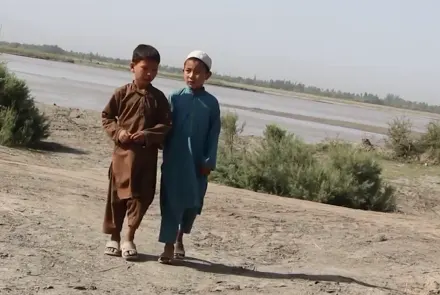Residents of Jazeera-e-Torpi in Imam Sahib district, Kunduz, are calling for educational opportunities for their children.
They say that around 1,200 families live in this area, but there are no formal schools.
Jazeera-e-Torpi is a border area in Imam Sahib district, Kunduz, located along the border between Afghanistan and Tajikistan.
Baz Muhammad Hanafi, one of the residents, said: “There are 1,200 families living on Jazeera-e-Torpi. The people are deprived of school education. Our request to the senior officials of the Department of Education is to pay serious attention to Jazeera-e-Torpi. There is no primary school, no middle school, and no high school. There are only local classes that come to us for five or six months.”
Omar Sayed, another resident, added: “There is no school at all, neither primary nor formal. A formal school must be built for us so our children can learn something.”
The Kunduz Department of Education, however, pledged that they will address the residents’ demands.
Hizbullah, the head of Kunduz’s Department of Education, said: “Imam Sahib is one of the most populous districts. The area you mentioned is deprived and situated between two rivers. Their children have been deprived of education. We have started efforts to establish two or three formal primary schools to solve their problem.”
Previously, residents of other remote areas in Kunduz called for addressing health, educational challenges, and the implementation of development projects in their regions.
Residents of Raghistan district in Badakhshan have constructed a school with classrooms and a medical center with more than six million Afghanis from their personal funds.
The construction of this school and medical center in the village of Dahan Shala, Raghistan district, has addressed the challenges faced by residents of several villages in this district.
Nazrullah, one of the residents, said: “The children here used to study in the open air, under the sun and rain. With the cooperation of the teachers, we were compelled to collect money from the people to build a medical center and this school.”
Qutbuddin, another resident, said: “With the cooperation of the district chief, we collected some money from the people and built this school for our children.”
The students have found the construction of these classrooms impactful for their education, stating that they used to study under the sun and in the open air.
They are asking the authorities to provide educational materials, desks, and chairs as well for them.
Subhanullah, one of the students, said: “We used to study in a tent. We don’t have books or any other educational materials.”
Saleemullah, another student, said: “We used to study in a tent, and it would rain. Now that the building is constructed, it has no doors, no windows, no desks, and no books.”
The district chief of Raghistan says that in the past nearly three years, more fundamental projects have been carried out in this district using the personal funds of the people.
Hayatullah Mohsin, the district chief of Raghistan, Badakhshan, said: “In the past three years, we have built nearly three to four schools and clinics with the cooperation of the people.”
The Badakhshan Directorate of Education stated that still 40 percent of the schools in this province do not have buildings, and students study under tents or in the open air.—Tolonews










